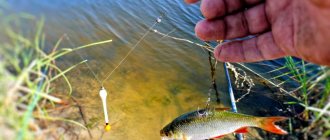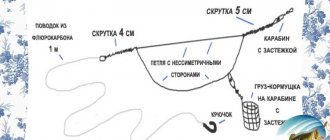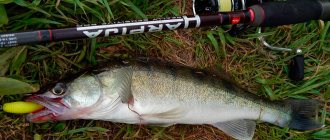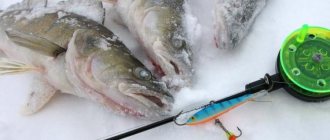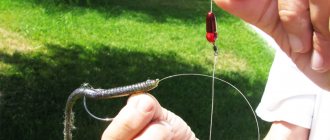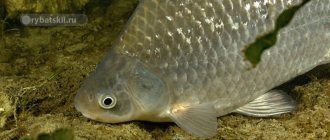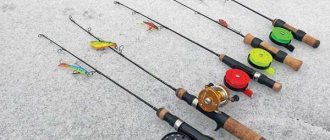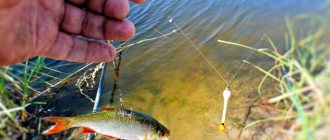The best fishing tackle for pike perch is the time-tested donka. Despite its outward primitiveness, it allows you to hunt fanged predators even with irregular biting. This is impossible when using a spinning rod in any interpretation, since fishing becomes unstable and short-term. And the donka is installed for a long time in a promising place, which increases the chances of a good result.
Large pike perch is a fisherman's dream
What does the equipment consist of?
Bottom gear comes in different types:
- Telescopic rod. Length - 2-3 meters. If fishing is carried out in a reservoir with a weak current or even standing water, a specimen with a dough of 40-60 grams is suitable, for intense flows - 100 grams.
- Reel - This will be a spinning reel with a 3000 spool. It will have a friction clutch and a “bayrunner” system.
- Line - Since you plan to catch trophy fish, you need a strong line. It must have a cross-section of at least 0.35 mm.
- Feeder - use for bottom hunting is quite promising. The container simultaneously serves to deliver complementary food to the desired area and as a sinker when casting gear. After casting, the feeder will lock and will not allow the equipment to move.
Donka is one of the most productive gear for catching pike perch.
It is advisable to include a bite alarm in the design of the donkey.
Donkey installation
The best way to rig a donkey for pike perch is when all the points are taken into account. This helps to avoid mistakes in the future (for example, fish disappearing, form breakage, etc.). Instructions:
- Unfold the telescopic spinning rod. All skip rings are placed in an even row to avoid loop-like scaffolding.
- For a plug rod, the mounting points are first checked for dirt and other debris, then collected.
- Place the reel on the butt. This is the area near the handle, which is secured with 1-2 nuts or with a latch.
- Wind the braid onto the spool.
- One end of the fishing line is passed through the rings.
- They fold back the inertia-free bracket and make two windings with scaffolding, which is then secured with a simple knot. Close the bracket.
- Prepare sections of fishing line from 30 to 70 cm long, sharp hooks with thickened shanks for leashes. A loop is made at one end and a hook is tied at the other end.
- Before tightening, the knot is moistened with water.
Design of a donkey for pike perch.
Necessary things for attaching a feeder according to the Paternoster type of equipment:
- bait container;
- monk;
- swivel;
- fluorocab wood;
- hooks
How to knit tackle:
Cut half a meter from the base monofilament line.
- Bend it in half so that one end protrudes 10 cm.
- The swivel is fixed by casting.
- Attach a carabiner and a feeder.
- A double knot is made 10-12 cm below the swivel.
- Small loops are formed at the ends of the fishing line.
- They take another piece of fishing line, 1 m long, on which they attach a hook at one end and make a loop at the other.
- Fix the feeder using a leash using the “loop to loop” principle. The monk is attached in the same way.
Now you can move on to setting the bait.
A classic donka requires a lot of investment. So, you will need many leashes, which are mounted on the main cord at intervals of up to 7 meters. For an elastic donkey, you need a model 1 mm thick with a length of 1/7 of the base line. Weights are taken flat, which hold the tackle in the current.
Donka with rubber shock absorber
Catching pike on donkeys from a boat in channels, creeks, and narrow rivers
The installation described below is used permanently in local creeks, whirlpools, channels, streams and rivers, where the distance between opposite banks allows.
A strong cord is pulled through the channel. Prepared bottom rigs are attached to it from the boat. They are pieces of monofilament 0.4 mm in diameter and 5 - 7 meters long, to which a metal leash with hooks for live bait is attached to the end.
At 50 - 70 centimeters from the leash, a weight is attached directly to the main line, which prevents the bait fish from pulling the bait to the side.
You attach live bait and cast out the rig. If there is a current, then you swim to the shore with the current. Once every hour or two, if you couldn’t detect a bite using a stretched cord, check.
Lures for fishing for pike perch
Pike perch is a cautious fish, often changing its behavior. Reacts to changing weather conditions. Therefore, before you go hunting, ask local anglers about fanged preferences. This will increase the chances of a successful outcome. If this is not possible, you need to take different baits with you.
Fish bite better on what is found in the same body of water.
Live bait for pike perch should have an elongated body, which is due to the structural features of the mouth.
Bait can be:
- bulls;
- minnows;
- roach;
- white bream;
- silver bream;
- dace;
- ruff;
- earthworms;
- maggots;
- bleak;
- leeches;
- perches;
- crucian carp;
- crayfish;
- toothless shells;
- lamprey;
- frogs.
The baits must be alive and moving, only then can you count on a trophy specimen. When fishing for pike perch in the current, it is permissible to use artificial fish (made of silicone). It is important to have a float that will keep the bait in the upper water layers and attract prey.
Active bait attracts predators more.
Feeders are loaded with boiled pearl barley mixed with fish offal, chopped worms and fresh bull liver. The smell of such components attracts fanged predators from afar.
How to attach live bait
Live bait - in order to attract the attention of fish and provoke it to attack. Therefore, a movable nozzle is required that makes strong oscillatory movements. If the fry or other living creature is lethargic, the predator will not bite.
Live bait mounting options:
- Using a double hook that is hooked through the mouth. The method is suitable for reservoirs with medium water flow pressure.
- In the center of the fish in the area of the spinal ridge, but without damaging it. Otherwise, the baitfish will lose activity. The hook is launched under the scales from the side of the caudal fin.
- A rubber band is placed between the fin and tail. And a hook is already threaded through it. As a result, the live bait is not damaged.
Methods for attaching live bait to a hook
Features of catching pike perch with live bait
Since this type of fishing does not apply to regular fishing, you need to choose the right place, and for this it is advisable to know where pike perch usually hangs. Spinners know such places, and in this sense it is easier for them. This method is used from the second half of June until the end of October. In mid-autumn you can take out the spinning rod again. The fish go to deeper places, so catching them with live bait becomes problematic. With the arrival of frost, the pike perch slides into holes.
Fishing with live fish has its advantages. Firstly, you can fish with several gears at the same time. Secondly, a cautious predator does not expect a trick from the fry and takes it more readily than artificial bait, and therefore fishing brings better results. Thirdly, in search of pike perch you don’t need to walk a lot; you can relax in nature, leaving many kilometers of marches for the fall.
If there are advantages, there must also be disadvantages, and there are some in fishing with live bait. The first and main thing is that fish need to be caught or bought and stored. Anyone who has set out to catch live bait with their own hands knows that on the day of fishing there will be no fry near the shore, although just yesterday he was organizing real games in the same place. Therefore, it is better to prepare live bait in advance. For storage you need a spacious container and a cool room; a basement or cellar is good for these purposes, but not everyone has one.
In the first half of summer and late autumn, a steep river bank is chosen for fishing. From July onwards, fishing from a gently sloping bank will be more effective. On particularly hot days, the pike perch goes deeper, so it is cast away from the shore. On such days, he can stand on shallow slopes of the riverbed. It is good to catch a predator from the shore on medium-sized rivers, the width of which does not exceed 150 meters, or on ponds. Tackle for catching pike perch with live bait is selected individually. Some fish excellently with a classic donka with an inertial Neva reel, some prefer a sliding rig, others use modifications with a float, a spinning or feeder rod.
The search for a place begins with studying the bottom. If, when casting, the sinker sinks into silt, you need to look for another section of the river or lake. Pike perch prefers hard ground. Having tapped the bottom and determined its character and relief, you can proceed directly to fishing.
The best time to catch pike perch is at night, morning and evening twilight. At the end of summer, in September and early October, it is still possible to catch pike perch using live bait at night. For night fishing, it is advisable to get a light bite indicator. A headlamp will also come in handy. When going to a pond, you should make sure that fishing is as comfortable as possible.
Search and selection of location
The season of the year is not important, since pike perch is always faithful to its location preference. Pike perch likes to hide at the very bottom of the reservoir, where there is a lot of garbage. It waits for its prey near strong currents, selecting fish weakened by resistance to the water.
Where else is it recommended to install donks:
- on the border of a smooth transition between shallow water and depth;
- deep plateaus with intense water flow;
- cliffs with turbulent pools and opposite currents;
- areas where there are springs under water;
- snags, dead wood and other rubble.
Fishing technique
The tactics for catching pike perch are not as complicated as they seem. The first thing you need to do is mix the bait. To do this, combine ingredients of plant origin (porridge) with crushed living ingredients (worms, maggots, bloodworms). Flavorings with the smell of crab or meat are added there. Let the mixture sit for about half an hour.
In the meantime, the depth of the reservoir where fishing is planned is measured. You can do this with a special marker float or resort to stepped wiring. Next, they feed the place by launching the feeder - making several successive casts of the bottom tackle to the desired point. When the bait container reaches the bottom, a sharp cut is made so that the bait falls out.
The technique for fishing for pike perch is almost the same from a boat and from the shore.
The process of catching pike perch:
- Fill the feeding container to the maximum.
- Hooks with bait bait are pressed into the bait mass.
- Cast as far as possible.
- Fix the tackle on the stand.
- Stretch the fishing line and connect the bite alarm.
- Connect the friction braking device.
You will have to wait about 20 minutes for a bite, then the equipment will be re-thrown. If no bite is observed for an hour or more, it is recommended to change the parking area or bait. When biting, they make a sharp hook, without delaying a minute.
From the shore
When fishing for pike perch from the shore, you must first find a convenient area to install a donkey. Clear of excess vegetation and debris. The exit from the water must be free in order to unhinderedly fish for prey.
Not all pike perch areas can be reached from the coastline. This fish lives mainly on channel bends, sharp river turns with cliffs, in the shade of snags, among stones and near riffles. The predator appears on the shallows mainly at night.
Video on how to catch pike perch using live bait from the shore on a donk:
From the boat
Since pike perch behaves very carefully, you need to swim to the place as silently as possible. For fishing from a boat you will need:
- Sheer bottom tackle - installed at depths where long casting is not required. You can use a reel or reel on a small fishing rod.
- Short spinning rod up to 2 meters long.
- Any type of tackle (except elastic). True, the wiring is done slowly, without jerking. Otherwise, the baitfish may get caught on snags or plants.
- Bite alarms of any type (they use bells, but light or electronic ones are suitable).
When catching a fanged one from a watercraft, it is better to use special clamps for the fishing rod. They are mounted to the side.
A simple way to make donka
First way. Simplest. We pass the end of the fishing line through two silicone stoppers. We use fishing line with a thickness of 0.40 millimeters. As you can see it is quite thick. Thanks to this, the line has less stretch, which is convenient when casting and when freeing the bottom if it gets caught on a snag.
The stoppers will serve us to regulate the height of the nozzle from the bottom. We hang a weight on the end of the main line. We select the weight of the load depending on the strength of the current, the main thing is that our nozzle is not blown to the side. Between the stops we attach a carabiner with a swivel, which will help us against twisting our gear.
We tie a fluorocarbon leash up to 0.25 millimeters thick and 20-30 centimeters long to the swivel. We attach a hook to the end of the leash. It can be either offset or regular with notches. The equipment is ready.
Our stoppers help regulate the height at which the bait will be placed. If desired, you can leave the bait on the bottom or raise it into the water column without changing the installation and length of the leash. And when fishing for pike perch, the stops with the leash slide towards the sinker, which significantly reduces the possibility of getting caught. The sinker and the fish will be close to each other and will easily come ashore together.
The leash should be thinner than the main line. This will provide us with a better bite from the cunning pike perch, and our tackle will be less tangled.
Advantages and disadvantages
Often, promising areas for catching pike perch are in rivers with moderate and intense currents, where the use of gear based on a long rod is impossible. A donka with a selected load easily solves this problem.
Donka fishing does not depend on weather variations
The advantages of bottom equipment are obvious if there is a stormy current in the reservoir or with powerful gusts of wind. Then spinning fishing does not make sense due to the waves and the lack of opportunity to make full-fledged fishing. Donks are more effective in this regard because they do not depend on weather conditions. Additional advantages:
- installation of gear at different depths;
- the ability to cast bait over long distances;
- using a bite alarm;
- combining the processes of fishing and feeding, which increases the chances of catching.
Despite the many advantages, there are disadvantages. So, there is a dependence on the bottom topography. It is impossible to fish with a donkey on rivers in the mountains or where there is intense water movement or a sloping bottom.
Bottom tackle loses productivity when it is heavily overgrown underwater. Such anomalies are fraught with the hooks getting caught, as well as the fish leaving where it cannot be pulled out.
Tips for Beginners
If you take a dead bait, then you need a float
. It is impossible to predict all the moments when hunting for pike perch, but some tips will help novice anglers:
- It is better to remove the live bait from the bucket, since hands moistened with water do not burn the fry’s body, and it remains just as mobile;
- a place for casting gear is selected with a small table (free space) so that the fish can move freely and attract large fish;
- After each fishing, you must ensure that the hook does not bend;
- you need to catch pike perch with live bait from the shore on the bottom in complete silence;
- waterfowl predators attack bait aggressively and with lightning speed, so it is better to have a catching device nearby (for example, tenash);
- the bait must be active - dead or dead baitfish will not attract prey;
- in hot weather, pike perch are searched for at depth, where it prefers to hide in holes and among vegetation;
- in summer, schools of pike perch are located mainly in the shallows - the fish bite better;
- if large individuals (1.5 kg) are not found in a particular place, you can replace the thick fishing line with a thinner one;
- When catching a predator from a boat, it is not wise to use a form longer than 2 meters, but from the shore, a longer one will do.
These recommendations will help beginners return home with a rich catch.
Catching and mounting donkey for pike perch video:
Tackle
Feeder gear is excellent for catching pike perch with live bait: you can make long casts from the shore, and it is perfectly suited for landing large fish. There are no strict recommendations on fishing strategy. Some people act by analogy with a classic feeder, that is, they are based in one place; for others, searching for pike perch seems more interesting. In the second case, fishing is more reminiscent of spinning fishing with probing the entire water area. This does not affect the equipment.
You can fish with or without a rod. In the latter case, take a regular flyer, like for a donkey or an elastic band. Feeder rods with a weight of 100 g or more are also suitable for catching pike perch with live bait. They allow you to cast heavy equipment quite far from the shore. In fact, there are no special differences in the elements of gear for white fish and predators. The same rod and reel that you use to catch bream. Reel size – from 3000. Powerful carp reels are not needed here.
Next is the fishing line. Take the braided line. Elastic monofilament lines have stretchability, which definitely interferes with fishing for pike perch. The jaw of this fish is strong; in order to pierce it with a hook, the hook must be clear. If you plan to catch large pike perch, the cross-section of the cord should be at least 0.16 mm, and better - 0.22 mm. This will allow you to throw the tackle to the far edge, and will also prevent the line from breaking when fighting a trophy predator.
The equipment designed for catching pike perch with live bait from the shore is quite simple. This simplicity lies in its effectiveness, because the fewer elements, the less likely it is that a big-eyed pike perch will suspect a trap. An important part of the equipment is the leash. No matter how strong the temptation may be to set a steel string in order to prevent the pike from biting, you should not do this. The pike perch sees a metal leash perfectly and will not approach the bait, no matter how appetizing the bait looks.
You will have to sacrifice something - either catch pike perch and know that a toothy one can cut the line, or not catch pike perch and keep the tackle intact. The conclusion is obvious: you need to take risks. Fluorocarbon is used as a leader for rigging zander. It is almost invisible in the water, durable, but the pike cuts it easily, so cuts are inevitable. If you are counting on a pike perch bite, you will have to come to terms with this. The fluor diameter ranges from 0.25 mm to 0.30 mm.
There are several rig options for live bait fishing. From the shore, pike perch are most often caught using gear that includes the main line, one or more leashes, hooks and sinkers. To secure the leashes, use either rubber stoppers or knots on the fishing line. Stoppers are more convenient, as they allow you to make sliding equipment.
Tips for a fisherman: Mechanical bite alarm for a bottom fishing rod - Tips for a beginner
You can also hook live bait in different ways. If a tee is used, then the fish is hooked by the back, head, belly or tail. A single hook can be pulled through the mouth and brought out on the back. This type of baiting resembles the connection of a silicone twister and a jig head. Experienced fishermen prefer to place live bait behind the head, since this is where the attack of the pike perch is directed.
If you are not a supporter of passive fishing and prefer to move along the river, then you will be interested in an article about catching pike perch using wobblers.
